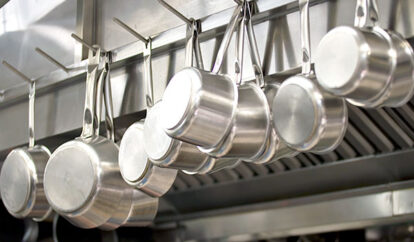Buying used restaurant equipment is mostly a financial decision. After all, running a restaurant is expensive. Besides the cost of kitchen equipment, there’s rent and utilities, business permits, insurance, food costs, employee wages, and many, many more expenses that are both planned and unexpected.
It’s understandable, then, that you’ll look for ways to get a leg up. But, while used restaurant equipment can save you money, if not purchased right, it can be a mistake. Equipment does break down, which often leads to high repair costs, meaning you’re out of pocket and without essential equipment to run your business.
Luckily, we’ve got you covered. Use this guide to learn absolutely everything about sourcing used commercial kitchen equipment so you can make informed buying decisions.
- Pros and cons
- What to keep in mind before buying
- What equipment is worth buying used and what isn’t worth the risk
- Where to buy
- Equipment financing – yes you can actually get financing for your second-hand purchases!
- Insurance coverage for used equipment
- An alternative to buying used: Leasing
The Pros and Cons of Buying Used Restaurant Equipment
Pros:
Besides the cost savings, there are several other advantages to buying used kitchen equipment:
- You can negotiate the price with independent sellers to an even better bargain
- It’s easy to find gently-used equipment from restaurants that have closed down
- Some equipment will still be under warranty, so you don’t have to pay for repairs costs if it breaks down – just be sure to check the manufacturer’s warranty
- Buying used doesn’t have the negative associations it once had. It’s a legitimate market with many places to buy
Cons:
- Many of the warranties are no longer valid, meaning you’re responsible for repair costs
- Repairs can be costly – often more than the initial purchase price
- Compared to new equipment, you have a limited selection of products to choose from
- There’s often no history of ownership or repairs
What to Keep in Mind Before Buying Used Equipment
Always do your due diligence before buying used. You don’t want to make a purchase, and later discover damage you didn’t know about.
There are many places you can find used kitchen equipment such as second-hand dealers or through independent sellers. Here’s what to keep in mind before buying:
Purchasing from a reputable dealer
When purchasing from a reputable second-hand dealer or online store, you can generally feel confident about the purchase as they usually inspect the equipment to ensure it’s in working order before pricing it. But, it never hurts to err on the side of caution—ask the seller to provide a certificate that confirms working order.
Buying from a private seller
Private sales can be a little tricker and it’s worth doing the following:
- Research the person you’re buying from. For example, check to see if they had a restaurant and determine how long they were in business. This will give you an idea just how used the equipment is
- If you can, test the item to see that it actually works. If you can’t, you may prefer to do business with those second-hand dealers who can furnish a certificate
- Check for any blemishes and scratches – it may help you negotiate a better price
- Ask if the product is still under warranty and get paperwork to confirm the warranty status
- Consider taking your chef along as he or she will have a better idea of what to look for
Regardless who you buy from, remember the following:
- Ask for the measurements of the equipment and compare it to your kitchen space to make sure it will fit
- Buy used commercial restaurant equipment that can handle the wear and tear of a commercial restaurant, not residential grade designed for households. Residential ovens and stoves, for instance, aren’t intended to run for long periods.
What Equipment Is Worth Buying Used
Certain equipment is worth buying used, others are not worth the compromise and you should definitely buy new. Here’s what you should and shouldn’t buy used, why, and tips to help you evaluate the equipment.
Yes! Buy these used
- Gas equipment: Compared to electric equipment, gas equipment is easy to repair, breaks down less often, and parts are readily available.
- Take note: Despite cost savings of repairing parts, day-to-day operational costs are higher.
- Ovens and ranges: These are perfect for resale as they have a long lifespan.
- Pro tip: Take your chef along while inspecting equipment to evaluate the equipment before buying by checking that the oven and stove top heat evenly, the cooking surface is even, and the seals are intact.
- Tableware: Restaurant-grade dishes and glasses are usually designed for frequent use, making them a perfect second-hand purchase. Other tableware to look for includes salt and pepper shakers, and condiment baskets.
- Take note: A limited selection may make it challenging to find tableware that matches your restaurant concept.
- Small appliances: It’s easy to find equipment like pans, pots, blenders, and kitchen utensils, with many resellers providing bundle purchases so you can get items at a “steal.” Some retailers may even guarantee certain appliances for a length of time.
- Pro tip: Don’t forget to test electrical equipment to ensure it’s working before buying.
- Fryers: Like ovens and ranges, fryers have a long lifespan which makes them an ideal second-hand buy.
- Tip: When buying fryers check that the oil container is watertight as splits leak oil.
No! Don’t buy these used
1: Fridges and freezers
Why?
- There’s no assurance that the fridge or freezer you buy used will meet the health code standard
- You don’t get the maximum life of your purchase
- Repairs can be expensive and cost more than the initial purchase price
- A used fridge that breaks down can have devastating ripple effects on your restaurant:
If food goes bad, you lose inventory. You then have to buy replacement food which takes suppliers a few days to deliver. This replacement food increases your food costs, and in turn, decreases your margins.
Plus, what do you do during the wait time? Sure, you’ll adapt and create a plan, but you’ll also probably lose sales and profits on dishes you could have sold to your patrons. Finally, you also have to explain the entire messy situation to customers who are probably disgruntled by this point.
Investing in a new restaurant-grade fridge is that important.
- Ice machines
Why?
Cross-contamination leads to damaged equipment or, worse, the health inspector shutting you down.
Where to Buy Used Equipment
Selling used kitchen equipment is now a legitimate market, and there are many places to buy.
Let’s look at a few of these, plus the pros and cons of each.
1. Local used equipment retail stores
You’ll likely find one of these retail stores in your neighborhood. They buy, sell, and trade used restaurant equipment, and have numerous advantages:
- You can inspect the equipment’s condition
- It’s easy to take measurements of the equipment and visualize exactly how it will fit into your restaurant
- Sales experts are available to answer questions. They give you detailed comparisons of brands and share sales expertise you won’t get online
But, the one big drawback – as is the case with many used equipment suppliers – is that they have limited options.
2. Independent sellers
Because many private sellers are unable to furnish a certificate or provide any guarantees, you need to do your due diligence to ensure you’re getting what you pay for. It really is a case of buyer beware.
Do your research and you’ll find excellent deals. Some sites to look at include Kijiji in Canada and Craigslist in North America.
3. Resale stores
Resale stores have a used section or only sell used equipment. Though many have a limited selection, some verify, certify, guarantee, and even refurbish specific equipment, so you know you’re getting good quality. Here are some examples of resale stores by region:
- U.S. online: Equippers, Burkett Restaurant Equipment and Supplies
- Canada online: Silver Chef, Abco Food and Restaurant Equipment
- New York: Atlantic Restaurant Equipment
- Chicago: City Food Equipment Co, Midwest Restaurant Equipment Supply and Manufacturing
- Toronto: Accurate Repairs and Food Equipment, Continental Restaurant Equipment
4. Auction houses
Restaurants that have closed down and want to liquidate their assets without spending time finding suitable buyers often use auction houses. You can visit the local auction house in your area or even shop online – an option many auction houses now offer.
While you should perform your own assessment and ask about warranties, many auction houses inspect and evaluate the equipment because they have to price it. So, if you want to get a bargain while having peace of mind, auction houses can be a great option.
Below are examples of auction houses by region:
- U.S. online: PCI Auctions, Auction Zip, RCI Online Auctions, Restaurant Auction Company
- New York: Michael Amodeo Auctions
- Chicago: Bob King Auctions
- Canada: Benaco, Storey’s, Haymach
Pro tip: Use storage locker auctions to find more deals. Some restaurants pay to store perfectly running equipment they’re not using. If restaurants close down or unable to pay for these storage lockers, they put them on auction.
5. Online suppliers
Online suppliers let you quickly compare a wide variety of brands and prices without having to visit a store. However, you’re unable to test the equipment and shipping can become expensive for those big-ticket items – though some suppliers do cover shipping.
Below are some examples of online suppliers that, in addition to selling new equipment, sell used and even “never-used” (scratch-and-dent items):
- U.S.: Webstaurant Store
- Canada: Canadian Restaurant Supply Ltd
Used Restaurant Equipment Financing
Equipment financing is a loan that lets you finance the value of your equipment. Unlike traditional financing which requires you to have sources of capital to guarantee the loan, the equipment is the collateral, meaning you don’t have to put any other collateral forward.
There are other benefits of equipment financing:
- Your collateral isn’t tied up, allowing you to pursue other lending options to grow your business
- If you don’t have upfront cash, you can still get the equipment without having to wait
- Flexible payment options are available, and you can sometimes negotiate with the lender
- You may receive certain special tax deductions under IRS 179 for purchasing equipment
But there are drawbacks:
- You don’t qualify for financing if you’re a new business. You have to be open for a length of time – anywhere from one month to a year
- Not all lenders cover financing for used equipment, with some limiting it to only specific brands. They usually state these limitations in their terms and conditions which also specify extra fees, penalties, late charges, unexpected taxes, and various other unwanted clauses. Read these terms and conditions to make sure you’re happy with your financing arrangement before proceeding.
Places to get financing include your bank and alternative lenders like ARF Financial and Thinking Capital.
Insurance Coverage for Used Equipment
Insurance is vital whether you’re buying used or new equipment. What if your restaurant burns down? What if your fridge is stolen? What if…?
Insurance covers you for these “what if” moments. It gives you peace of mind and prevents scenarios where you are responsible for damages out of your own pocket – which can be financially devastating and difficult to recover from.
Different types of insurance provides cover for these moments including general liability insurance, property insurance, business interruption insurance, and food contamination insurance. However, the coverage you need for used equipment is property insurance.
Property insurance
Property insurance will cover your used kitchen equipment, furniture, building, and property. While policy costs vary based on factors like location, sales and level of coverage you want, expect to pay annual premiums anywhere from $1,000 to $2,500. In either case, ensure you confirm policy costs with your broker.
Here are some places you can approach for property insurance:
- EverGuard Insurance if you run a nightclub, tavern or bar
- Berkshire Hathaway GUARD Insurance if you have a deli or neighborhood restaurant
- Plymouth Rock if you own a food truck (they provide commercial auto insurance)
Remember: You’re liable for equipment insurance even if you’re renting from an owner who has insured the building.
Need some guidance on buying restaurant insurance coverage?
Read this comprehensive post “What Kind of Restaurant Insurance Does a Restaurant Need?”
An Alternative to Buying Used: Leasing
Besides buying, you can lease both new and used equipment. Yes, many companies do offer leases for used equipment. If you want to lease used equipment, make sure you to ask if they offer lease agreements. Not all do. One popular cutlery supplier, for example, provides leases for both new and used equipment.
Let’s explore the pros and cons, the different types of leases, and places to lease.
Pros of leasing:
- Weekly or monthly payments means predictable expenses without a high lump sum deposit
- You save working capital for business areas that truly need it
- You can easily upgrade your equipment when the lease period is over
- You’re not responsible for the repair costs if the equipment breaks or malfunctions
- Leasing is ideal if you don’t want to deal with the struggle of repairing specific restaurant equipment that’s prone to breakage. Dishwasher anyone?
- There’s usually an option to buy the equipment at the end of the lease period
Cons of leasing:
- Buying equipment builds equity, which you can sell if you need money. But when you lease you pay a monthly amount – that’s money you never see again
- Like financing, leasing arrangements have terms and conditions including termination clauses and unwanted charges. For example, you’ll likely pay extra if you want to switch to another brand because the current one doesn’t work like you thought it would
Types of equipment leases
- Lease to own is the most common type of lease. You lease the equipment with a buyout option at the end of the lease period. Monthly payments are high with a lower buyout amount
- Fair market value leases let you get the latest equipment for a reduced monthly cost. At the end of the lease, you can choose to buy the equipment at fair market value, return it, or continue leasing
- Quarterly equipment leases are subject to higher payments and interest rates
- Seasonal leases are perfect for restaurants with marked slow and busy seasons. You can pay for the lease during high-revenue periods.
Places to lease equipment
- New York: CKitchen and Rogers & Sons
- Chicago: Gator Chef and Restaurant Appliance Depot
- Toronto: Nella Cutlery and Silver Chef
Conclusion
It’s understandable that you would try to lessen the financial burden of starting and running a restaurant by buying used kitchen equipment, but that same equipment can cost you more money in the long run. That’s why it’s crucial to equip yourself with information about buying used so you can make an informed decision:
- Understand the benefits and drawbacks
- Do your due diligence before buying
- Know what equipment is worth risking on a used purchase – and what isn’t
- Learn where to buy reliable used equipment
- Understand options in equipment financing
- Recognize there are alternatives to buying – you can lease
- Don’t forget about insurance coverage for those “what if” moments
Now you know the ins and outs of buying used commercial kitchen equipment and you’ll grow more confident with each used purchase you make. Finally, trust your gut – if a potential sale doesn’t feel quite right, it probably isn’t, and the best option is to walk away.





